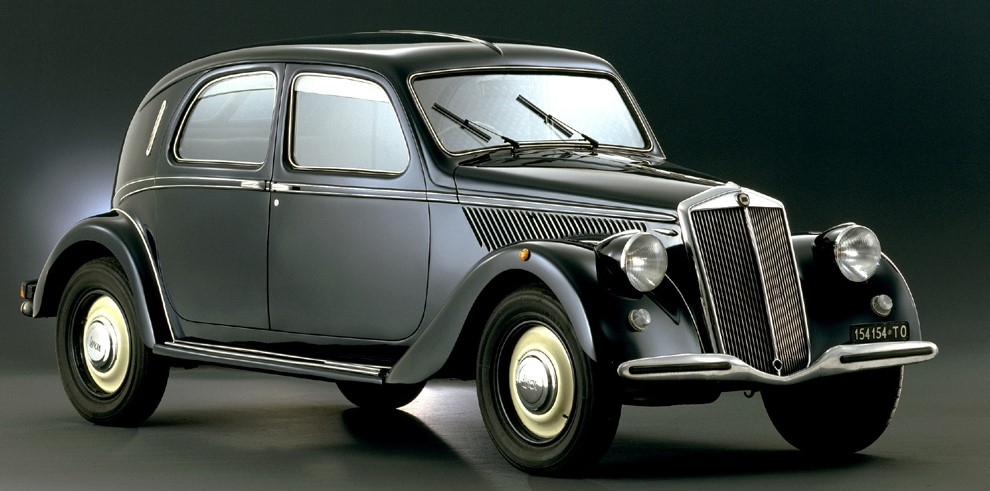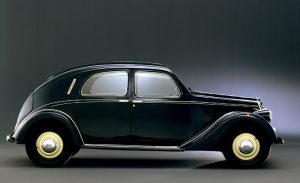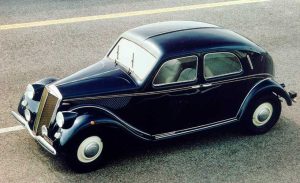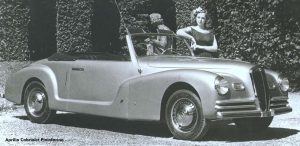
The Aprilia, introduced in 1936, was the spiritual legacy of Vincenzo Lancia, who had passed away a few months before the commercial launch of the car. Provided with a unitised body integrated with the chassis without B-pillar, the appearance of the car was truly innovative. It stood out among the sedans of its day for its particularly aerodynamic line and light-weight, securing a top speed of about 130km/h and good fuel efficiency at the same time. The narrow-V4 with hemispherical combustion chambers contributed to this result. In addition to telescopic independent front suspensions, by now standard on Lancias, the car fitted independent suspensions on the rear axle.
The history of the Lancia Aprilia is intriguing, because the car is regarded as the spiritual testament of the marque’s founder Vincenzo Lancia, who died in 1936 just before its official presentation. The Aprilia is a technological marvel delivering high performance, excellent pick-up and outstanding road holding, characteristics that made this sports car almost unbeatable when racing in the Touring sub-1500 cc class.
Its sophisticated mechanics are based on a 48 HP four-cylinder narrow-angle V engine of 1.353 cm3 with hemispherical combustion chambers, overhead camshaft, light-alloy monoblock and cast iron liners. Its self-supporting bodywork and independent four-wheel suspension were highly refined and innovative features in its day.
The contours were particularly modern and the car’s unladen weight of 850 kg, allowed it to quickly reach a remarkable top speed of 125 km/h.
The Aprilia was an instant success and 10,354 examples of the 238 and 238L (Luxury) models were produced between 1937 and 1939. A further 4350 chassis of the Aprilia first series (239 model) were produced for coach-built bodies.
The car first entered the Mille Miglia in 1938 and achieved its first significant result in 1940 when Bassi/Furielli finished 27th overall and third in class. But the Lancia Aprilia’s biggest achievement came in 1947 when the pairing of Tullini/Rossi won the TI sub-1500 cc class ahead of two other Aprilias driven by Piccinini/Marsaglia and Rollino/Poggio. That was during the post-war reconstruction years, when fuel and tyres were still rationed and the competitions were extremely difficult to organise.
For Lancia, the Aprilia simultaneously marked the end of one era and the beginning of another. Technologically speaking, this was a supremely refined model, with a load-bearing body, a compact narrow V engine, independent suspension on all four wheels and extremely innovative aerodynamic lines.
During the 1920s, the invention of wind tunnels allowed industrial designers to seek new levels of performance for motor vehicles by improving their aerodynamics. In the United States, “streamline design” was all the rage, a trend for producing sinuous and aerodynamic lines, starting with aeroplanes, then trains and then cars, increasing their speed but also emphasising their extravagant stylistic features.
This movement reached Italy in the 1930s when streamlining, a symbol of modernity, inspired the lines of the new Lancia Aprilia. But compared to the American style, Vincenzo Lancia’s trusted designer Battista Falchetto – who had shared the honours for the stunning design of the Lambda – created a car with fewer frills and more concrete lines, aimed at improving aerodynamics. The grille and windscreen were therefore slightly inclined, and the egg shape – considered at the time the most efficient profile from an aerodynamic point of view – gave character to the rear part. The compact and streamlined bonnet was made possible by the small size of the narrow V engine… an authentic concentrate of technology. It consisted of a light alloy monobloc with cast iron barrels, V valves controlled by rockers moved by an overhead camshaft and a hemispherical top on the combustion chamber. With only 1,352 cc it generated 48 HP which, thanks also to a total weight of only 850 kg, plus an excellent aerodynamic coefficient of just 0.47, thrust the Aprilia up to 125 km/h.
The Aprilia was a true Piedmontese aristocrat, refined and precise in every detail. Its famous four pillarless doors, a true Lancia icon, also have an extraordinary curved profile and invisible hinges. The famous click – the sound of the doors closing – underlined the scrupulous attention to the smallest details in design and assembly which typified Lancia’s outstanding modus operandi, providing an unforgettable grace note. The interiors, especially in the Luxury version, featured a classy geometric instrument panel on a grey background with black and white graphics: the square speedometer and clock perfectly matched with the rectangles chosen for the thermometer and the fuel gauge. The Lancia cloth upholstery (available on request in leather), the door panels, the roof covering and the rubber mats were the final touches of a creation which was the closest possible motorcar version of the classic Turin interiors of the period.
Its extremely low weight was mainly due to the load-bearing body: a Lancia patent – first seen in the 1920s on the Lambda – which, by overcoming the classic architecture which kept the chassis and bodywork separate, improved torsional rigidity and significantly reduced volumes. The independent suspension on all four wheels, with rear transversal leaf spring and front coil springs, enabled the Lancia Aprilia to offer road grip and passenger comfort that was much superior to most of its contemporary rivals.
The Lancia Aprilia contained all the most innovative and refined technical solutions that were so dear to Vincenzo Lancia. It constituted a pinnacle of motorcar production, carried out under the direct supervision of the founder of the Turin company. The name of the car came from that of an ancient Lazio town: a characteristic that linked it to its predecessors, the Artena and the Astura.
The Aprilia is considered the spiritual testament of Vincenzo Lancia, who passed away in February 1937, before being able to witness the model’s market debut.
The Lancia Aprilia was presented to the public at the thirtieth edition of the Paris Motor Show, in October 1936. On February 15, 1937 its creator had a sudden and fatal heart attack, just before the car went into production. He was only 55 years old. Thus the Aprilia became universally seen as the spiritual testament of Vincenzo Lancia, becoming a huge commercial success, which continued even after the adversities of the second World War.
The first series of the Lancia Aprilia was produced from 1937 to 1939 in 10,354 units: a Sedan in standard and Luxury trims, to which were added 4,350 chassis for custom-made versions, on which the best Italian coachbuilders revelled in producing streamlined and elegant spiders and cabriolets. Pinin Farina’s aerodynamic coupé was highly original, with its characteristic flattened muzzle, the central position of the 2 + 2 passenger compartment and an elegant tail.
Two years after the start of production, the second series was born, characterised by the increase in displacement to 1,486 cc. The power remained unchanged, but this improved the elasticity of the engine and the maximum speed. Despite a weight increase to 950 kg, it gained 1 km/h. In the decade from 1939-1949, 11,082 sedans were produced plus 2,252 chassis for coachbuilders.
The production of the Aprilia continued – with a further 703 exemplars – even after the Second World War, a period in which the model, despite being almost ten years old, could still be proud of its highly modern mechanics and settings. It held its place in the market right up to the last days of production, and in racing it remained the undisputed dominator of the Tourism class up to 1500 cc for years: it also triumphed in the Mille Miglia of 1947 thanks to its powerful acceleration and peerless road holding.
To this day, more than eighty years after its presentation, the Aprilia is considered a timeless pioneering car which, by gathering all the best of Lancia’s innovative philosophy, inaugurated a new era in motoring. Vincenzo Lancia was usually hypercritical about his cars, but after test driving the Aprilia prototype he spontaneously exclaimed: “What a magnificent car!”.
In 2017, to celebrate the model’s 80th anniversary, an exemplar of the Lancia Aprilia I series was completely restored by FCA Heritage technicians, with a view to participating in the Mille Miglia that year. The car is normally exhibited at the Heritage HUB as part of the “Archistars” thematic exhibition, along with seven other technical masterpieces that introduced significant innovations in automobile architecture.





You must be logged in to post a comment.